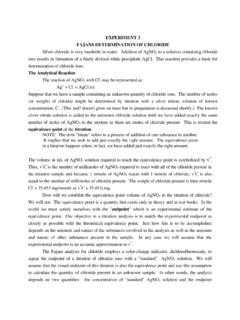Transcription of LABORATORY EXPERIMENT 5 PRECIPITATION TITRATION …
1 LABORATORY EXPERIMENT 5 PRECIPITATION TITRATION WITH silver nitrate . The AgNO3 solution (~ M) needs to be standardized using NaCl as a primary standard. You will perform standardization using Fajans method with adsorption indicator and using Mohr method with chromate indicator. Both titrations are to be done in triplicate. 1. The Determination of Chloride by TITRATION with an Adsorption Indicator Discussion In this TITRATION , the anionic adsorption indicator dichlorofluorescein is used to locate the end point. With the first excess of titrant, the indicator is incorporated into the counter-ion layer surrounding the silver chloride and imparts color to the solid.
2 To obtain a satisfactory color change, it is desirable to maintain the particles of silver chloride in the colloidal state. INDICATOR Dichlorofluorescein indicator (sufficient for several hundred titrations ). Dissolve g of dichlorofluorescein in a solution prepared by mixing 75 mL of ethanol and 25 mL of water. PROCEDURE Dry the NaCl sample at 110 C for about 1 hr; allow it to return to room temperature in a desiccator (this will we done for you). If M AgNO3 is to be used, weigh a NaCl sample into a 500-mL volumetric flask, and take 25-mL aliquots for TITRATION . To each, add 5 drops of indicator.
3 Titrate with AgNO3 to the first permanent pink color of silver dichlorofluoresceinate. Note: Colloidal AgCl is sensitive to photodecomposition, particularly in the presence of the indicator; attempts to perform the TITRATION in direct sunlight will fail. If photodecomposition appears to be a problem, establish the approximate end point with a rough preliminary TITRATION , and use this information to estimate the volumes of AgNO3 needed for the other samples. For each subsequent sample, add the indicator only after most of the AgNO3 has been added, and then complete the TITRATION without delay.
4 2. The Determination of Chloride by the Mohr Method Discussion The Mohr method uses chromate ion as an indicator in the TITRATION of chloride ion with silver nitrate . The first excess of titrant results in the formation of a red silver chromate precipitate, which signals the end point. INDICATOR Sodium chromate, 5% Indicator PROCEDURE Introduce several drops of Na2 CrO4 solution, and titrate to the first permanent appearance of red Ag2 CrO4. Calculations: From the volume of silver nitrate solution used fopr TITRATION , calculate the molarity of AgNO3. As usual, aliquotetotalAgNOAgNONaClNaClVVVCFWm =100033 This equation should be solved for CAgNO3 totalAgNONaClaliquoteNaClAgNOVVFWVmC =331000 Standard silver nitrate solution can be used for various titrations .
5 I. Potentiometric Halide TITRATION with Ag+ Mixtures of halides can be titrated with AgNO3 solution as described in the textbook. In this EXPERIMENT , you will use the apparatus in the textbook to monitor the activity of Ag+ as the TITRATION proceeds. The theory of the potentiometric measurement is described in Section 15-2 of the textbook. Each student is given a 250-mL volumetric flask containing g of KCl plus 1g of KI (both weighed accurately). The object is to determine the quantity of each salt in the mixture. A M bisulfate buffer (mixture of NaHSO4 and H2SO4, pH 2) will be available in the lab.
6 PROCEDURE Dilute to the mark and mix well. Pipet mL of unknown into the beaker, add 3 mL of bisulfate buffer, and begin magnetic stirring. Record the initial level of AgNO3 in a 50-mL buret and add ~1 mL of titrant to the beaker. Turn the pH meter to the millivolt scale and record the volume and voltage. Titrate the solution with ~1-mL aliquots until you can see two clear potentiometric end points. You need not allow more than 15 s for each point. Record the volume and voltage at each point. Make a graph of millivolts versus milliliters to find the approximate positions ( 1 mL) of the two end points.
7 Turn the pH meter to standby, remove the beaker, rinse the electrodes well with water, Now perform an accurate TITRATION , using 1-drop aliquots near the end points (and 1-mL aliquots elsewhere). You need not allow more than 30 s per point for equilibration. Prepare a graph of millivolts versus milliliters and locate the end points as in Figure 7-8 of the textbook. The I- end point is taken as the intersection of the two dashed lines in the inset of Figure 7-8. The Cl- end point is the inflection point at the second break. Calculate grams of iodide (I) and milligrams of chloride (Cl) in your unknown.
8 AliquotetotalAgNOIIVVVCFWm =100013 aliquotetotalAgNOClClVVVVCFWm =1000)(123 II. Fast Determination of Sodium Chloride in Ketchup. Weigh g of ketchup, transfer it into a beaker for TITRATION , add 30-40 mL of water, 2 mL of bisulfate buffer (see above), shake well, and titrate with AgNO3 to the same chloride end point as in the previous determination. Calculate the percent of NaCl in ketchup 1000)(33 AgNOAgNONaClNaClVCFWm = ketchupNaClmmNaCl%100)%%( =
